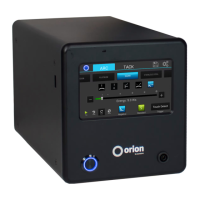7
OrionWelders.com
Hands On: Try welding on a flat plate with 30, 50, 75, 100, and 150 Ws of energy. Stay at max
length, and make sure you have a sharp welding electrode. (Orion 150s was used here)
Lower energy settings allow for welds on small parts and delicate features. Having both power and precision allows users
to have maximum versatility. Selecting the proper weld setting is a matter of user preference and application necessity.
Hands On: Try welding at 3, 10, 25 Ws of energy. Stay at max length, and make sure you have a
sharp welding electrode. (Orion 150s was used here)
WELD ENERGY VS. WELD LENGTH OR TIME
What happens if the length (time/duration) of the weld is adjusted? As can be seen in the figures below, the weld time
controls the size of the pulse to a smaller extent then the energy. It also controls the smoothness of the weld puddle.
Because the smoothness of the weld spot is also related to the internal stress of the weld joint – a smoother weld will have
less stress. It is recommended that the user keep the weld length at the max time for most applications. e left image
was welded at 25 Ws with 3, 7, 11, and 15ms weld length. e right image was welded at 75 Ws with 20, 40, and 60ms weld
length.
e two weld parameters (energy and length) can be understood with the following analogies. Consider your Orion welder
to be like a water tower. e amount of water in the tower is like the energy stored in the welder. Firing the welder is like
opening a large valve to let water out. e length parameter in the welder can be thought of as how long the valve is left
open. You can discharge a very small amount of water by only having the valve open a short time, or you can allow all of the
water out of the tower by leaving the valve open for a longer period of time.
e actual weld puddle can be understood better using the following analogy. ink of the metal surface as a pool of
water in its frozen state. Your welder’s arc discharge impacts the “water” causing it to melt. e arc discharge also causes
the now liquid “water” to ripple – similar to when a stone has been thrown into a body of tranquil water. If the arc energy
is removed quickly the “water” freezes instantly and the ripples remain frozen into the water’s surface. If the arc heat
is removed slowly, the ripples have a chance to dissipate and go away completely before the water’s surface refreezes.
is is why short weld length causes the weld spot to look rippled. Keeping the weld length at its max will leave the weld
looking smooth and clean.

